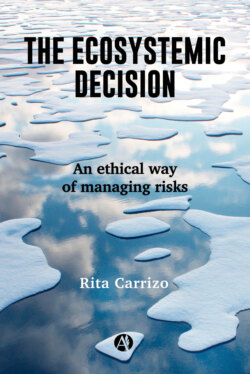The Ecosystemic Decision

Реклама. ООО «ЛитРес», ИНН: 7719571260.
Оглавление
Rita Carrizo. The Ecosystemic Decision
The Ecosystemic Decision. An ethical way of managing risks
Table of Contents
Sinopsis
Introduction
Chapter 1. The decision-maker and the ecosystem duo. 1.1 A macro-historical view of human action
1.2 Decisional archetypes
The decision-making process
The economic man
The administrative man
1.3 The decision-maker in the light of the systemic approach
Systems Thinking
What does it mean to think systemically?
What are the pillars of systems thinking?
The linear decision-maker
Chapter 2. The decision-maker’s driver
2.1 Digging into the biology of the decision-maker
Biology and Ecology
Sociobiology
Cooperation
Altruism
Genetics
AVPR1a gene research
COMT Val158Met gene study
Where does this reflection take us?
Fear written in the genes
2.2 Cultural aspects of the decision-maker
The metaphysical paradigm
A life that transcends experience
The being respects certain attributes
A definition of “the truth”
The primacy of reason
Where do these four metaphysical foundations take us?
How did the metaphysical myth manage to permeate culture?
What was so special about this perspective that made it such an “evolutionary success”?
Finally, how does this view encourage linear thinking?
The Humanist or homocentric paradigm
Do we need to be immortal?
The result-oriented creed
How does this myth encourage linear behaviour?
2.3 The existential pain
Chapter 3. The pending learning. 3.1 Ecosystemic ethics
3.2 Language: the apple of Eve
3.3 A powerful look at language
The principles of OL
The observer principle
The action principle
Levels of learning from the OL perspective
The principle of the system
Chapter 4. The ecosystemic decision, decision-makers and their risk profiles
4.1 The decision-maker, an onto-linguistic observer
Heuristic processes
Neural networks
Emotionality in the heuristic process
Neuroplasticity of the decision-maker
Some conclusions
4.2 Risk profiles
Microcosmic perspective
The ecosystemic decision-maker
Learning to identify and abandon ecosystemic paradigms
To appreciate being a part of the ecosystem in which the ED participates
To understand which decisions or which aspects of decisions are heuristic or automatic in nature
What abilities characterise the ED? Ability to “exit from transparency”
Ability to feel the protagonist and with the power to bring about the desired changes
Ability to exit automatic operation
Ability to use linguistic acts
Grounding judgements
Judgements vs. assertions
Chapter 5. What is risk?
5.1 Linear decisions, linear risks
5.2 Looking at risk from an ecosystemic perspective
Risk dwells in the OLO decision-maker
When talking about risk, it is not necessary to talk about time
Uncertainty
5.3 Ecosystemic dimensions of risk
Traditional risk
Opportunity risk
Use of risk
5.4 Risk factors
5.5 Emerging risk
High degree of uncertainty
Lack of consensus
Uncertain relevance or evolution
Difficult to understand and communicate
Difficult to assign responsibility
Chapter 6. Ecosystemic risk management (ESRM) 6.1 What is it in charge of?
6.2 ERM, SRM and ESRM
Management
The decision
6.3 ESRM and the 2020 pandemic
Appendix. An Ecosystemic Approach to the 2020 Pandemic
Introduction
1. The speech
1.1 Speeches that followed medical directions
1.2 Virus underestimation speeches
2. Decisions taken
2.1 Day 1 and first steps
2.2 Conducting tests
2.3 Full lockdown or social distancing
2.4 Monitoring COVID-19 mobile apps and geolocation
2.5 Ecosystemic consequences
3. Conclusions
References
Articles and internet materials
Referencias apéndice
Biography
Отрывок из книги
RITA CARRIZO
Talking about risks implies talking about decisions, both those we do make and those we do not. Then learning how to manage risk requires considering the decision content and, most importantly, understanding what drives us to "make" a decision. We would all probably agree that the current state of the global ecosystem demands urgent action. Radically changing the way in which we decide seems necessary if we want all the species of the planet to continue to coexist. But, how do we do it? Why are we still chained to a decision-making behaviour that has proven to be poor in terms of sustainability and ethics? It may be that the answer lies in our own evolution, but what kind of biological and cultural evolution process transformed humans into "not so good" decision-makers at recognising and becoming responsible for the impacts and potential responses of the ecosystem towards their decisions? This book approaches these questions with a view to understanding who has been and who currently is the Western decision-maker. It proposes a paradigm shift that enables an "ecosystemic" management of decisions and risks, made possible through a deep reflection in which the author, Rita Carrizo, sought to integrate contributions from the fields of biology, genetics, sociobiology, neurosciences, systems thinking, and the ontology of language.
.....
The reflection up to this point triggers a question: why was not everything abandoned when the undesirable consequences of some decisions began to be evident? Apparently, the change from hunter-gatherers to sedentary agriculture did not bring an improvement in the overall quality of life of the individuals. On the contrary, it forced them to work longer hours and enjoy much less; or, even when they were allowed to have and store food in large quantities, it was less nutritious and varied, and competition for food brought more violence into their lives. Later in history, the industrial revolution showed its B-side of pain and suffering for the victims of misery, unhealthiness, or the exploitation of man by man. Even today, when there is ample evidence of the fate of our planet if the pace of production, emissions, pollution, and consumption continues on its unbridled course, why do we not abandon it all and recalculate the path?
These seem to be dilemmas that require an in-depth enquiry to be able to outline an answer that will surely be incomplete. Nevertheless, and this being part of the purpose of this book, I propose to start this journey by making use of Systems Thinking (ST). This discipline has been used since the mid-20th century by several branches of science as an integrative perspective when it comes to understanding and describing organised complexity.
.....